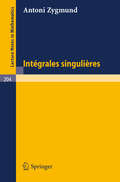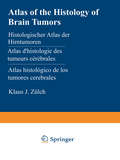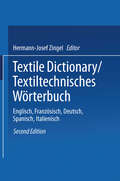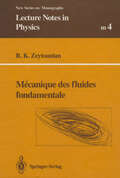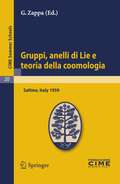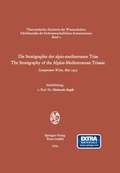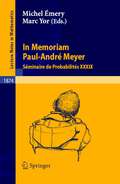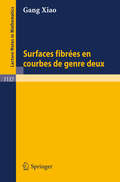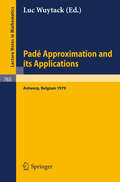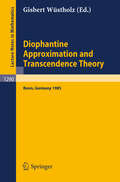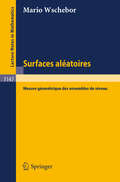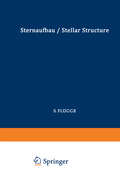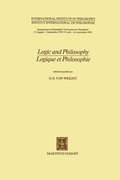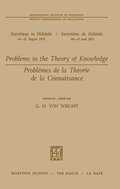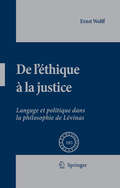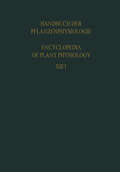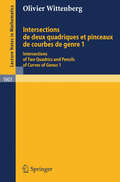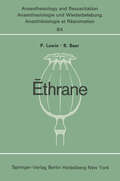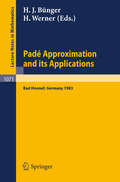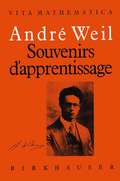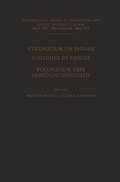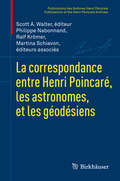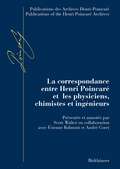- Table View
- List View
Atlas of the Histology of Brain Tumors / Histologischer Atlas der Hirntumoren / Atlas d’histologie des tumeurs cérébrales / Atlas histológico de los tumores cerebrales / Гистологический атлас опухолей мозга человека: (pdf)
by K. J. ZülchMecanique des fluides fondamentale (Lecture Notes in Physics Monographs #4)
by Radyadour K. ZeytounianCe cours de mecanique des fluides est avant tout un cours theorique qui repond aux questions fondamentales de ce sujet de recherche. Les quatre premiers chapitres presentent les equations propres a determiner l'ecoulement de fluide considere et diverses solutions. Les chapitres 5 et 6sont consacres aux problemes lies la stabilite, aux bifurcations et aux comportements chaotiques. Le livre donne un vision globale des questions traitees en mecanique des fluides qui sont a la base de toute la recherche, de la modelisation et de toutes les applications dans ce domaine.
Gruppi, anelli di Lie e teoria della coomologia: Lectures given at a Summer School of the Centro Internazionale Matematico Estivo (C.I.M.E.) held in Saltino (Firenza), Italy, August 31-September 8, 1959 (C.I.M.E. Summer Schools #20)
by G. ZappaR. Baer: Complementation in finite gropus.- M. Lazard: Groupes, anneaux de Lie et problème de Burnside.- J. Tits: Sur les groupes algébriques afffines. Théorèmes fondamentaux de structure. Classification des groupes semisimples et géométries associées.
Die Stratigraphie der alpin-mediterranen Trias / The Stratigraphy of the Alpine-Mediterranean Triassic: Symposium Wien, Mai 1973 (Schriftenreihe der Erdwissenschaftlichen Kommission #2)
by Helmuth ZapfeOrganisiert im Hinblick auf das Internationale Geologische Korrelationsprogramm (IGCP)
In Memoriam Paul-André Meyer - Séminaire de Probabilités XXXIX (Lecture Notes in Mathematics #1874)
by Marc Yor Michel ÉmeryThe 39th volume of Séminaire de Probabilités is a tribute to the memory of Paul André Meyer. His life and achievements are recalled in this book, and tributes are paid by his friends and colleagues. This volume also contains mathematical contributions to classical and quantum stochastic calculus, the theory of processes, martingales and their applications to mathematical finance and Brownian motion. These contributions provide an overview on the current trends of stochastic calculus.
Pade Approximation and its Applications: Proceedings of a Conference held in Antwerp, Belgium, 1979 (Lecture Notes in Mathematics #765)
by L. WuytackDiophantine Approximation and Transcendence Theory: Seminar, Bonn (FRG) May - June 1985 (Lecture Notes in Mathematics #1290)
by Gisbert WüstholzSurfaces Aleatoires: Mesure Geometrique des Ensembles de Niveau (Lecture Notes in Mathematics #1147)
by Mario WscheborAstrophysik II: Sternaufbau / Astrophysics II: Stellar Structure (Handbuch der Physik Encyclopedia of Physics #11 / 51)
by Marshal H. Wrubel H. C. Arp G. R. Burbidge E. Margaret Burbidge Hans E. Suess Harold C. Urey Lawrence H. Aller P. Ledoux Th. Walraven Armin J. Deutsch E. Schatzman Cecilia Payne-Gaposchkin F. ZwickySects. 12, 13. 89 sequence and that subgiant and fainter stars in globular clusters have ultraviolet excesses. When dealing with stars whose physical properties are imperfectly under stood, such as in globular cluster stars, we cannot rely too heavily on the empiri cal calibration by the kinds of stars used to define Fig. 5, to determine their true, unreddened U-B, B-V curve. But if by a combination of arguments, principally the reddening in the region of the stars we do known about, we can assign a fairly probable unreddened U-B, B-V curve to a group of stars about which we know little, the argument may be turned around. In this case some information may be gained about the energy envelope of the stars by examining the differences between the normal two-color index curves for the unknown group of stars compared to the known. In general there seem to be two possible causes for different stars defining different normal sequences in the U-B, B-V plane. One, the relative energy distribution in the continuum in the U, B and V photometry bands are different. An example of this is the effect of the Balmer depression in supergiants. This, of course, requires deviation from black body radiation curves for one or both groups of stars. This cause seems to be the dominant effect for very blue, hot stars where the depression of the continuum by absorption lines is at a minimum.
Logic and Philosophy / Logique et Philosophie (Institut International de Philosophie #5)
by G. H. WrightThe Entretiens of the Institut International de Philosophie for 1978 were held in connection with the World Congress of Philosophy in Dusseldorf, from August 27 to September 1. The theme of the Entretiens was Logic and Philosophy (Logique et philosophie). The undersigned, then President of LI.P., was responsible for the planning of the programme. The programme was designed to consist of four sections with the headings Classical and Intuitionist Logic, Modal Logic and its Applications, Inductive Logic and its Applications, and Logic and Epistemology. The aim was also to convey to philosophers who are not experts in logic an informative and representative impression of some of the main sectors of the vast and rapidly expanding field of philosophical logic. At the same time it was thought that this impression should not be conveyed in the form of a series of survey papers but through presentations and discussions of specific topics falling under the main headings men tioned above. For each section a rapporteur was nominated to read a paper and an interlocuteur to comment on it. The programme chairman is grateful that he was able to engage a representative selection of front rank philosophi cal logicians to perform the various tasks. The papers and the comments are printed in this volume in the order in which they appeared in the Programme of the Entretiens.
Problems in the Theory of Knowledge / Problèmes de la théorie de la connaissance (Institut International de Philosophie #1)
by G. H. WrightSymposium in Helsinki, 24-27 August 1970 / Entretiens de Helsinki, 24-27 août 1970
De L'éthique à la Justice: Langage et politique dans la philosophie de Lévinas (Phaenomenologica #183)
by Ernst WolffEmmanuel Lévinas est le philosophe de la non-indifférence; il n’est en aucune sorte un philosophe indifférent. Son inquiétude personnelle et engagement politique ont trouvé une expression philosophique dans une quête à deux versants. Dans le versant ontologique, il cherche à montrer que même si l’homme est l’événement de compréhension de l’être, tout l’homme et toute signification ne se réduisent pas à la compréhension de l’être seul. Dans le versant politique, il s’interroge sur la possibilité de soumettre la tendance totalitaire de toute politique à une recherche de justice qui ne dépend pas finalement de la politique même. Mais ces deux versants n’en font qu’un. La découverte d’une signification qui excède la compréhension de l’être – l’éthique – fournit en même temps la source de renouvellement de la justice. Ainsi, par cette double question, Lévinas nous présente les fils conducteurs de notre enquête: une signification au-delà de la compréhension de l’être et sa portée éthique, que nous appelons «langage» et que nous explorons dans la perspective de son importance politique. Les études analytiques dans lesquelles les notions de politique et de langage fonctionnent comme clef d’interprétation mutuelle débouchent sur une critique centrée sur deux problèmes: l’impossibilité d’interpréter la signifiance de l’autre et le danger inhérent à la conception d’une justice dépassant l’Etat.
Plant Respiration Inclusive Fermentations and Acid Metabolism / Pflanzenatmung Einschliesslich Gärungen und Säurestoffwechsel: Part 1 / Teil 1 (Handbuch der Pflanzenphysiologie Encyclopedia of Plant Physiology #12)
by J. WolfIntersections de deux quadriques et pinceaux de courbes de genre 1: Intersections of two quadrics and pencils of curves of genus 1 (Lecture Notes in Mathematics #1901)
by Olivier WittenbergCet ouvrage est consacré à l'arithmétique des surfaces fibrées en courbes de genre 1 au-dessus de la droite projective, et à l'arithmétique des intersections de deux quadriques dans l'espace projectif. Swinnerton-Dyer introduisit en 1993 une technique permettant d'étudier les points rationnels des pinceaux de courbes de genre 1. La première moitié de l'ouvrage reprend et développe cette technique ainsi que ses généralisations ultérieures. La seconde moitié, qui repose sur la première, porte sur les surfaces de del Pezzo de degré 4 et sur les intersections de deux quadriques de dimension supérieure; les résultats annoncés dans [C. R. Math. Acad. Sci. Paris 342 (2006), no. 4, 223--227] y sont démontrés.
The Secrets of Facilitation: The S.M.A.R.T. Guide to Getting Results With Groups
by Michael WilkinsonThe Secrets of Facilitation delivers a clear vision of facilitation excellence and reveals the specific techniques effective facilitators use to produce consistent, repeatable results with groups. Author Michael Wilkinson has trained thousands of managers, mediators, analysts, and consultants around the world to apply the power of SMART (Structured Meeting And Relating Techniques) facilitation to achieve amazing results with teams and task forces. He shows how anyone can use these proven group techniques in conflict resolution, consulting, managing, presenting, teaching, planning, selling, and other professional as well as personal situations.
Ēthrane: Proceeding of the First European Symposium on Modern Anesthetic Agents Hamburg, November, 9th and 10th, 1973 (Anaesthesiologie und Intensivmedizin Anaesthesiology and Intensive Care Medicine #84)
by E. WiethoffPade Approximations and its Applications: Proceedings of a Conference held at Bad Honnef, Germany, March 7-10, 1983 (Lecture Notes in Mathematics #1071)
by H. Werner H. J. BüngerSouvenirs d'apprentissage (Vita Mathematica #6)
by André WeilL’auteur, mathématicien, mais dont l‘horizon ne s‘est jamais borné aux mathématiques, évoque ici les souvenirs d’une carrière qui l’a mené dans plusieurs continents : Italie et Allemagne d’abord, puis l’Inde où il séjourna et enseigna à une époque décisive pour l’histoire de ce pays, et où il rencontra brièvement Ghandi, et plus longuement Jawaharlal Nehru ; l’U.R.S.S., à un moment où le stalinisme semblait se relâcher avant de rependre bientôt en toute férocité ; Princeton, le « clearing house » moderne des idées mathématiques, dit parfois le paradis des mathématiciens ; la prison, en Finlande, où, pris pour un espion soviétique, il manqua de peu le poteau d’exécution, puis en France où il fut condamné pour avoir tenté de se soustraire à ses obligations militaires, et où il eut le temps de rédiger à la prison de Rouen l’un de ses meilleurs travaux mathématiques ; l’Angleterre où il vécut la bataille de Londres avant de se retrouver en France et d’en repartir pour l’Amérique ; le Brésil enfin, terme de ses vicissitudes. A travers ces épisodes souvent pittoresques s’est déroulé un destin de mathématicien dont l’un des points saillants fut sa participation à la fondation du groupe Bourbaki, auteur collectif d’un traité déjà devenu classique.
Colloquium on Fatigue / Colloque de Fatigue / Kolloquium über Ermüdungsfestigkeit: Stockholm May 25–27, 1955 Proceedings / Stockholm 25–27 Mai 1955 Comptes Rendus / Stockholm 25.–27. Mai 1955 Verhandlungen (IUTAM Symposia)
by Waloddi Weibull F. K. G. OdqvistUpon the request of the International Union of Theoretical and Applied Mechanics (IUTAM) the Swedish National Committee for Mechanics organized a colloquium on fatigue, which was held at the Royal Institute of Technology (Kung!. Tekniska Hogskolan) in Stock holm, May 25-27, 1955. 35 lectures were delivered, principally dealing with problems of statistical and basic nature. Among the topics were to be found statis tical theory of fatigue, cumulative damage, mechanism of fatigue, me tallurgical aspects on fatigue, velocity of fatigue cracks, fatigue at elevated temperature, and fatigue at combined stresses. Lectures were going on simultaneously in two sections. Each lecturer had 15 minutes for presentation of his communication, and afterwards 15 minutes were reserved for discussion. Abstracts of the lectures were distributed about a month before the colloquium. The colloquium was attended by 149 participants from the follow ing countries: Denmark (1), Finland (2), France (5), Germany (6), Italy (2), Netherlands (2), Norway (2), Poland (2), Saar (1), Spain (3), Sweden (100), Switzerland (1), United Kingdom (10), USA (8), USSR (3), and Yugoslavia (1). A complete list of the participants will be found below. The languages of the Colloquium were English, French, German and Italian. No lectures were delivered in Italian. Also, all contributions to the discussions have been translated to one of the first three languages. Statements and opinions advanced are always those of the individual authors or participants in the discussions.
La correspondance entre Henri Poincaré, les astronomes, et les géodésiens (Publications des Archives Henri Poincaré Publications of the Henri Poincaré Archives)
by Scott Walter Ralf Krömer Philippe Nabonnand Martina SchiavonThe letters in this volume cover Poincaré's multifaceted career in astronomy in its entirety, extending from the time of his first publications in 1880 to the end of his life in 1912. At a tender age, Poincaré established his authority in questions of celestial mechanics, and his views were soon sought after on a vast array of questions by the leading astronomers and geodesists of his time, including C.V.L. Charlier, G.H. Darwin, H. Faye, F.R. Helmert, G. W. Hill, A. Lindstedt, A.M. Liapunov, N. Lockyer, S. Newcomb, K. Schwarzschild, and F. Tisserand. Poincaré and his correspondents take up topics ranging from the three-body problem and perturbation theory to the determination of the geoide and the equilibrium figures of rotating fluid masses. The volume also sheds light on Poincaré's three terms as president of the Bureau of Longitudes, where he guided French astronomy and geodesy through ambitious projects, such as the measurement of an arc of meridian near Quito.------Les lettres du troisième volume de la Correspondance de Poincaré scandent toute son œuvre astronomique, allant de ses premiers mémoires sur les courbes définies par une équation différentielle (1881), jusqu'aux analyses des hypothèses cosmogoniques (1911). Encore très jeune, Poincaré s'est fait remarquer pour sa maîtrise des questions de la mécanique céleste, de tel sorte que les astronomes et les géodésiens l'ont souvent interpellé, y compris O. Callandreau, C.V.L. Charlier, G.H. Darwin, F.R. Helmert, A. Lindstedt, A.M. Lyapunov, Simon Newcomb, Karl Schwarzschild et F. Tisserand.Avec ses correspondants, Poincaré abordaient les questions principales de l'astronomie mathématique, du célèbre problème des trois corps à la théorie des perturbations et aux figures d'équilibre des masses fluides en rotation. La correspondance de Poincaré éditée et annotée dans ce volume concerne, au-delà des mémoires mathématiques, l'activité de Poincaré en tant que Professeur d'astronomie mathématique et de mécanique céleste à la Sorbonne, rédacteur en chef duBulletin astronomique, et membre du Bureau des longitudes, que Poincaré a présidé à trois reprises. Sa correspondance illumine, dans ce dernier cadre, la réalisation de la mesure d'un arc de méridien à Quito, et le règlement d'un différend franco-brittanique à propos de la différence de longitude entre Greenwich et Paris.
La correspondance entre Henri Poincaré et les physiciens, chimistes et ingénieurs (Publications des Archives Henri Poincaré Publications of the Henri Poincaré Archives)
by Scott Walter Etienne Bolmont André CoretL'intérêt que portait Henri Poincaré (1854-1912) à des questions d'ordre physique a été durable et profond; elle couvre presque toute sa carrière, et marque l'histoire de la physique tout au long du 20ème siècle. Sa correspondance avec cinquante-et-un physiciens, quatre chimistes, et cinq ingénieurs commence dès 1879, lorsqu'il s'engage activement dans la recherche scientifique. Elle est rythmée par des grandes découvertes d'ordre expérimental, instrumental, et théorique. Henri Poincaré, while well-known as the most brilliant mathematician at the close of the 19th century, is also a founder of 20th-century physics, in virtue of his fundamental contributions to Maxwell's theory, systems dynamics, electron theory, relativity and quantum theory. These subjects and others are discussed in this critical edition of his correspondence with sixty physicists, chemists, and engineers.
